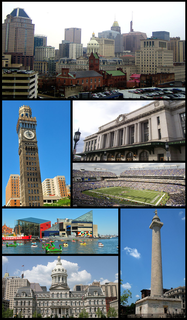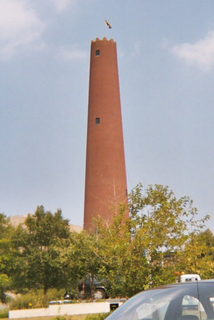
The Phoenix Shot Tower, also known as the Old Baltimore Shot Tower, is a red brick shot tower, 234.25 feet (71.40 m) tall, located near the downtown, Jonestown, and Little Italy communities of East Baltimore, in Maryland. When it was completed in 1828 it was the tallest structure in the United States.

Union Square is a neighborhood located in the Sowebo area of Baltimore. It dates to the 1830s and includes a historic district of houses and commerce buildings.
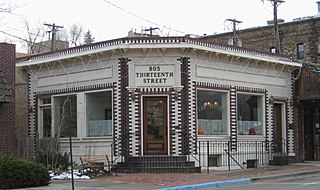
The Quaintance Block was the first storefront in historic downtown Golden, Colorado, to be listed on the National Register of Historic Places. Built in 1911, it is a one-of-a-kind architectural landmark combining Victorian and presaging modern styles, featuring unique experimental glazed bricks. It is also fondly remembered among locals as the Spudnut Shop.

The White Building, also known as the Heberling Building, is located in the city of Bloomington, Illinois, United States. Located along Bloomington's East Douglas Street, the building was added to the National Register of Historic Places in June 1994 and represents one of the better examples of Commercial style architecture still extant in the city. It was built by Bloomington resident Samuel R. White in 1894-1895 to house his furniture sales company. By 1903 the Heberling Brothers pharmacy and their associated businesses occupied most of the building and the White company had moved its facilities to a nearby location. The White Building is a five-story red brick building which is elaborately windowed and has a three-story connected extension to its west which probably predates it.

The Alex. Brown & Sons building is a historical structure located at 135 East Baltimore Street in Baltimore, Maryland. During the 20th century it served as the corporate headquarters for the banking firm Alex. Brown & Sons, the oldest in the United States when it was purchased by Bankers Trust in 1997. The two story building, completed in 1901 and designed by the partnership of J. Harleston Parker and Douglas H. Thomas. Jr., survived the 1904 Baltimore fire. The building was modified on the Calvert Street side and in the interior by the firm Beecher, Friz, and Gregg in 1905.

Mount Clare, also known as Mount Clare Mansion and generally known today as the Mount Clare Museum House, is the oldest Colonial-era structure in the City of Baltimore, Maryland, U.S.A. The Georgian style of architecture plantation house exhibits a somewhat altered five-part plan. It was built on a Carroll family plantation beginning in 1763 by barrister Charles Carroll the Barrister, (1723–1783), a descendant of the last Gaelic Lords of Éile in Ireland and a distant relative of the much better-known Charles Carroll of Carrollton, (1737–1832), longest living signer of the Declaration of Independence and the richest man in America in his later years, also the layer of the First Stone of the new Baltimore and Ohio Railroad, just a short distance away in 1828.

The H. L. Mencken House was the home of Baltimore Sun journalist and author Henry Louis Mencken, who lived here from 1883 until his death in 1956. The Italianate brick row house at 1524 Hollins Street in Baltimore was designated a National Historic Landmark in 1985. Mencken wrote of his home: "I have lived in one house in Baltimore for nearly 45 years. It has changed in that time, as I have—but somehow it still remains the same.... It is as much a part of me as my two hands. If I had to leave it I'd be as certainly crippled as if I lost a leg."
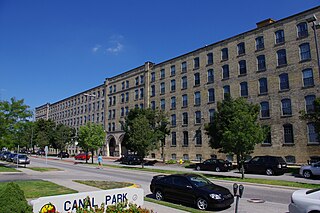
Berkey and Gay Furniture Company Factory is a manufacturing plant located at 940 Monroe Ave., NW in Grand Rapids, Michigan. It was listed on the National Register of Historic Places in 2000.
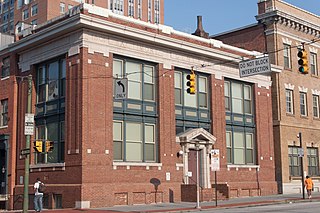
Baltimore General Dispensary is a historic public dispensary building located at Baltimore, Maryland, United States. It is three bays wide and two stories high, with running bond red brick foundation and building walls, and a water table constricted in 1911. The front features a simple cornice surmounting a stone entablature reading: 1801 Baltimore General Dispensary 1911. It is the only surviving building designed for Baltimore's oldest charity. The interior originally featured a large dispensary center on the first floor, separated for black and white patients. The rooms for surgical and medical aid on the second floor gave the poor a measure of privacy rarely available to charity patients.

The Baltimore Gas and Electric Company Building is a historic office building located at Baltimore, Maryland, United States. It is the former headquarters of the old Consolidated Gas, Light and Electric Power Company of Baltimore City, which was a merger at the turn of the 20th century of the former century old Gas Light Company of Baltimore with several other formerly competing gas and electric power companies which had risen in the late 19th century, to form a single metropolitan wide unified utility system. In 1955, the old cumbersome Consolidated title was jettisoned and the utility rebranded as the Baltimore Gas and Electric Company (BG&E).

George Knipp & Brother Building is a historic retail building located at Baltimore, Maryland, United States. It is a five-story brick commercial structure with a four-bay cast-iron façade, constructed about 1875. It features large window openings flanked by Corinthian columns. It was originally the location of John Knipps’ furniture business and his brother George Knipp's enterprise in gas fixtures and plumbing supplies. It was later occupied by a furniture and carpet firm and later a J.G. McCrory Co. store.

Mercantile Trust and Deposit Company is a historic bank building in Baltimore, designed by the Baltimore architectural firm of Wyatt and Sperry and constructed in 1885. It has a brick-with-stone-ornamentation Romanesque Revival structure, with deeply set windows, round-arch window openings, squat columns with foliated capitals, steeply pitched broad plane roofs, and straight-topped window groups. The interior features a large banking room with a balcony, Corinthian columns and ornate wall plaster work.

Gandy Belting Company Building is a historic loft building located at Baltimore, Maryland, United States. It is a brick masonry bearing-wall structure built in five sections. The sections built in 1888, 1890, and 1908 are four stories in height. The remaining two sections, built in 1908-1911 and 1911 respectively, are five stories in height. The Gandy Belting Company, (1888-1931) manufactureer of machinery belting.

Lion Brothers Company Building is a historic factory located at 875 Hollins St, Baltimore, Maryland 21201. It is a multi-level building that once housed the operations of the Lion Brothers embroidery company. The original building was constructed in 1885 and expanded several times over the subsequent 75 years. In 1958 the Lion Brothers moved their production facility to another location allowing Marcus & Farber and Globe Screen Printing to move in. The building has been vacant since 2002 and Cross Street Partners has plans to restore the building as a local innovation center.

L. Grief and Bro., Inc. Manufactory is a historic factory building located at Baltimore, Maryland, United States. It is a three-story brick and steel industrial building constructed about 1914-15. It features an expanse of multi-light steel windows, a metal cornice, and sawtooth monitors. It encompasses almost an entire city block and over 60,000 square feet (5,600 m2) of interior space. It served as a clothing factory for L. Greif & Bro., Inc., makers of the men's clothing brand, 'Griffin,' and for a time the country's second-largest men's clothing company. The company was sold to a national conglomerate in 1957.

Bagby Furniture Company Building is a historic factory building located at Baltimore, Maryland, United States. It is a four-story, "U"-shaped, brick factory building composed of three sections constructed between 1902 and 1907. Its exterior features segmental and jack arches above openings, a corbeled watertable, and a corbeled cornice. It housed the Bagby Furniture Company, which operated from 1879 to 1990.

The Hadley Furniture Company Building is a historic retail building at 651-659 Main Street in downtown Worcester, Massachusetts. The five story brick building was built in 1923-24 to a design by the local architectural firm of Cutting, Carleton & Cutting. The Hadley Furniture Company, founded in 1914, sought to expand from earlier premises closer to City Hall, and commissioned its construction. As a representative of a significant specialty retail presence in the city, and for its architectural styling, it was listed on the National Register of Historic Places in 2011.

The Union Baptist Church is a historic Baptist church building located at 1219 Druid Hill Avenue in central Baltimore, Maryland. The granite church was designed by New York architect William J. Beardsley and built in 1905 under the leadership of Rev. Harvey Johnson. The Gothic Revival structure features steeply pitched roofs, lancet windows, and distinctive buttressing on the front facade to provide support for the walls on a constrained lot size. The church was built for a predominantly African-American congregation established in 1852; its minister from 1872 to 1923, Rev. Harvey Johnson, was a prominent voice in the civil rights movement.

The Taft-West Warehouse, also known as the C.C. Taft Company Building, Plumb Supply Company, Ben's Furniture Warehouse, and Nacho Mamma's, is a historic building located in Des Moines, Iowa, United States. Completed in 1923, this three-story brick structure was built during a transitional period between the dominance of railroads the emergence of trucks servicing warehouses. It was designed by local architectural firm of Vorse, Kraetsch, & Kraetsch. It features cleans lines of the Commercial style as opposed to the fussiness of late Victorian styling that was dominant in a great deal of the city's commercial architecture. The building was also located in the Court Avenue wholesale district, and now it is only one of only five or six that remain extant. The building was constructed for the C.C. Taft Company. This firm and the O.B. West Company that succeeded it in this building, dealt in wholesale fruits, vegetables, candy and tobacco. The building was listed on the National Register of Historic Places in 2006.

The Commercial Credit Company Building, also known as The Residences at 300 St. Paul, is a historic building located in Baltimore, Maryland, United States. It is significant as the first post-World War II office building constructed in the city, its associations with the Commercial Credit Company who commissioned it, and the New York City architectiral firm Harrison and Abramovitz who designed it.
